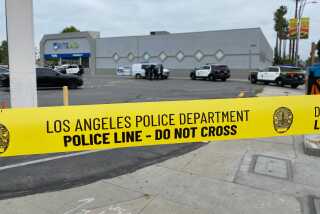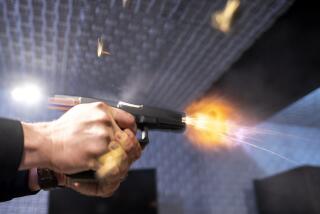Stun guns not a cure-all for police shootings, experts warn
- Share via
Lethal police shootings in Ferguson, Mo., and St. Louis this month, and a chokehold death in New York City in July, have been met with a question:
Why didn’t the officers use a Taser?
Although the use of stun guns has become prevalent in police departments throughout the country, law enforcement experts say the idea that the devices should be used in place of firearms is far from accurate.
Stun guns can prove a valuable alternative to gunfire or other methods of force, but experts say stun guns can be difficult to deploy in rapidly escalating and close-range situations. And they can prove deadly to suspects with certain health conditions.
“The original infatuation with stun guns has been kind of replaced. There’s a lot more caution in terms of when to use them. And certain people may have, for example, heart problems or arrhythmia and might be particularly vulnerable to the application of stun guns,” said Julius Wachtel, a criminologist at Cal State-Fullerton. “That apparently also applies to a lot of people who may be mentally unstable.”
The familiar conversation about stun guns gained momentum after the chokehold death of Eric Garner in New York City last month, and the more recent shootings of Michael Brown in Ferguson and Kajieme Powell in St. Louis.
Powell was fatally shot by two St. Louis police officers last week after they said he approached them with a knife.
The circumstances of Brown’s death remain the subject of intense debate. Ferguson police have said Brown and Officer Darren Wilson struggled over Wilson’s gun, then Brown fled, but turned around and charged Wilson, prompting the officer to fire.
But some witnesses contend that Brown had his hands up and was running away from Wilson when the officer shot him six times.
Stun guns probably would not have been a viable alternative in any of the situations, experts say.
Garner had health problems, including cardiovascular disease, which could have caused him to suffer serious injury or death if shocked with a Taser.
If the Ferguson Police Department’s account of Brown’s death is accurate, a stun gun would be an unlikely option to handle a charging suspect, experts say.
And in Powell’s case, the presence of a knife and the split-second decision the officers had to make also may have necessitated the use of a firearm.
“There has to be time to deploy the stun gun and it’s not always readily available,” said Wayne Fisher, a professor with the Rutgers University Police Institute in New Jersey. “Secondly, in the example of an armed offender closing in on the officer, it’s necessary at that point to use the level of force which has the highest opportunity for stopping the armed aggressor, and that would be a firearm.”
When used improperly, stun guns can be just as deadly as firearms, according to Donna Lieberman, executive director of the New York City chapter of the American Civil Liberties Union. While she believes, in certain situations, the devices could serve as a life-saving alternative to a handgun, stun guns are best used in concert with other tactics to help deescalate a situation, she said.
“I think that it’s hard to address every situation, but when there’s a dangerous situation and a likelihood that a stun gun will work and the other alternative is not some diffusion of the situation or some other physical approach, but rather deadly force, then it’s a no-brainer,” Lieberman said. “Police have to make spur-of-the-moment life-and-death decisions and when their instincts are wrong, the consequences are disastrous.”
Stun guns also have been linked to a number of high-profile deaths, including one in Ferguson in recent years. In 2011, 31-year-old Jason Moore suffered a heart attack after he was repeatedly shocked with a stun gun, according to a report in the St. Louis Post-Dispatch.
A wrongful death suit is pending in that case.
Stun guns are employed by a growing number of law enforcement agencies throughout the country. About 17,500 law enforcement agencies in the U.S. use various models of stun guns produced by Taser, according to Steve Tuttle, a company spokesman.
The devices are used by police agencies patrolling nearly every city in the U.S. with a population of 500,000 or more, Tuttle said. In cities of that size, only Boston, San Francisco and Detroit police do not use stun guns.
Although their use has spread, the idea that stun guns are always at the ready is a common myth. For example, most patrol officers in New York City do not carry them, according to Det. James Duffy, an agency spokesman. The devices are usually handled by supervisors and members of emergency service units.
Chicago and Los Angeles police use the devices more regularly, but both agencies require officers to qualify for their use.
Generally, the LAPD will use a stun gun only against an “aggressive or combative” suspect, according to an LAPD spokesman. But in South Los Angeles this month, officers shot Ezell Ford, a man with apparent mental problems, to death after he supposedly tackled an officer. (That case is under review, with some witnesses disputing the police version of events.)
The Chicago Police Department’s use-of-force policy suggests officers deploy stun guns against people who are “actively resisting,” but not necessarily assaulting an officer.
Lieberman said the perception that stun guns are not deadly can sometimes prove problematic. An ACLU study found many police departments in New York have lax rules governing officers’ use of the devices. The conventional wisdom that the devices are not harmful is also troubling, she said, because it can sometimes lead to insufficent officer training.
“I think the biggest problem with stun guns is because they are perceived as not-so-deadly force, the constraints on using them are less,” she said. “The reluctance to use them is far less.”
Fisher said stun guns are usually best used in situations where officers would otherwise have to subdue a suspect with a baton or other physical force. In those cases, stun guns are far less likely to cause permanent or serious injury.
“Generally a stun gun is usable where there is discretionary time during which the officer has to make a decision about the best course of action,” he said. “If the facts are such that deadly force is immediately called for, a stun gun is not a suitable alternative.”
Follow @JamesQueallyLAT for breaking news
More to Read
Sign up for Essential California
The most important California stories and recommendations in your inbox every morning.
You may occasionally receive promotional content from the Los Angeles Times.











